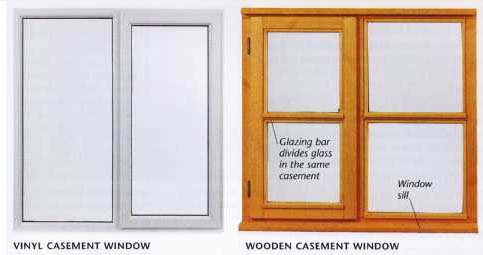Windows are available in a variety of designs and sizes. There are differences in opening mechanisms and structure, as well as the type of glass they contain. The following pages contain information on replacing and renovating windows, as well as installing catches, shutters, and glazing. Common minor repairs for windows are shown here.
TYPES OF WINDOWS
There are several different types of windows. Traditionally, most windows were side-hinged windows, referred to as casements, and sliding sash windows. New opening mechanisms such as friction and pivot hinges (opposite) are increasingly popular. Window materials, shapes, and sizes vary considerably, as does terminology, so you should read your manufacturer’s literature carefully. Replacement windows for older homes often need to be custom-built to your requirements.
CHOOSING WINDOWS
Commonly, the material and mechanism of a replacement window is chosen to match the originals. There are some exceptions -- new sash windows, for example, will often be equipped with modern spiral balances, although they look the same as original lead counterweight versions . If you are replacing all the windows in your property, or building a new home, then take time to consider energy-efficient products such as double and even triple glazing. Frames may have a sill attached, an optional sill, or none at all. If your old frame has a sill attached, make sure your replacement has one.

Parts of a casement window. Casement windows are
widely used. Many of the terms used to describe the parts that make
up a casement window also apply to other windows. The window is made
up of one or more opening casements, hinged along one side. Top-hung and side-hung casements are available. The metal casement shown here
combines opening, non-opening, and side-and top-hung casements.
Parts include: Awning; Mullions divide windows vertically; Transoms divide different
casements; Non-opening pane is built into casement; The top of the frame is called
the head; Jambs make up the sides of the frame; Side-hung casements are hung
on hinges attached along the jamb; The bottom of the frame is known as the sill.
Common types of windows:
Side-hinged casement and sliding sash windows are still very popular, although pivot and awning windows are becoming common. There are variations on these themes, with each type of window made in many different sizes, shapes, and styles.

Casement windows: As well as the metal casement shown
opposite, vinyl and wood casements are also common. In the following
pages, we have lots more information on the properties of different
materials. Shown above are a VINYL CASEMENT WINDOW, and a WOODEN CASEMENT
WINDOW: Glazing bar divides glass in the same casement; Window sill.

Double-hung window: A distinctive, traditional design
with two vertically sliding sashes. Modern sashes are made of wood
or vinyl, and some versions allow tilting of sashes for easy cleaning.
Custom casement screened window: Custom windows offer you a selection of sizes and styles that can meet any needs. When you order custom windows, you have options to include special glass, lites, or other features like this window screen. (Side swings out; Screen fabric rolls dawn)
Awning window: Butt hinges are used along the top edge of older designs; newer awning windows use friction hinges at either end of the top edge (see below). Both arrangements allow the bottom edge of the window to swing open.
TYPES OF WINDOW MECHANISMS
There are several different mechanisms used to open windows. How a window opens can have implications on how space in a room is used -- clearance may be needed to enable you to open some windows. Some types, known as “tilt-and-turn windows,” have combination hinges and can open vertically or horizontally, depending on how the handle is operated. The opening mechanism of an existing window can't normally be changed.

Butt hinge: This is the simplest opening mechanism.
Hinges are attached down one side, or along the top edge on a “top-hung”
casement.
Weights and balances: Vertically sliding sashes use lead weights or modern spiral balances to hold them in position. Horizontally-sliding windows run on tracks, similar to those for patio doors.
Pivots: Tilting casements pivot halfway down each side, or midway along the top and bottom of the frame. The pivots are designed to hold the window in any position.
Friction hinge: These are used on awning and casement windows. The hinges are at either end of the hinged edge, rather than along the edge itself. The “friction” holds the window in any open position.